calsfoundation@cals.org
Drew County
| Region: | Southeast |
| County Seat: | Monticello |
| Established: | November 26, 1846 |
| Parent Counties: | Arkansas, Bradley |
| Population: | 17,350 (2020 Census) |
| Area: | 828.66 square miles (2020 Census) |
| Historical Population as per the U.S. Census: | |||||||||
|
1810 |
1820 |
1830 |
1840 |
1850 |
1860 |
1870 |
1880 |
1890 |
1900 |
|
– |
– |
– |
– |
3,276 |
9,078 |
9,960 |
12,231 |
17,352 |
19,451 |
|
1910 |
1920 |
1930 |
1940 |
1950 |
1960 |
1970 |
1980 |
1990 |
2000 |
|
21,960 |
21,822 |
19,928 |
19,831 |
17,959 |
15,213 |
15,157 |
17,910 |
17,369 |
18,723 |
|
2010 |
2020 |
|
|
|
|
|
|
|
|
|
18,509 |
17,350 |
|
|
|
|
|
|
|
|
| Population Characteristics as per the 2020 U.S. Census: | ||
| White |
11,291 |
65.1% |
| African American |
4,846 |
27.9% |
| American Indian |
90 |
0.5% |
| Asian |
108 |
0.6% |
| Native Hawaiian or Other Pacific Islander |
13 |
0.1% |
| Some Other Race |
366 |
2.1% |
| Two or More Races |
636 |
3.7% |
| Hispanic Origin (may be of any race) |
656 |
3.8% |
| Population Density |
20.9 people per square mile |
|
| Median Household Income (2019) |
$46,997 |
|
| Per Capita Income (2015–2019) |
$25,543 |
|
| Percent of Population below Poverty Line (2019) |
18.8% |
|
Drew County is located at the edge of the Mississippi Alluvial Plain (the Delta) in the West Gulf Coastal plains region. Bayou Bartholomew, the longest bayou in the world, runs along the eastern edge of Drew County. The Saline River forms the southwestern border. The Monticello Ridge uplands extend from north of Star City (Lincoln County) through Drew County into Louisiana. The county is home to the University of Arkansas at Monticello (UAM), whose School of Forest Resources is the only such institution in the state, as well as SeaArk Marine, Inc., and other industries.
European Exploration and Settlement
Native Americans lived in southeastern Arkansas, including Drew County, for many years before European exploration into the region. By the late seventeenth century, French missionaries and explorers encountered the Quapaw in southeastern Arkansas. There is evidence that before the Quapaw settled in the area, the Tunica lived there as farmers prior to moving south into Mississippi and then Louisiana.
Louisiana Purchase through Early Statehood
Drew County was a small part of the land purchased by the United States from France in 1803 in the Louisiana Purchase. In an 1824 treaty, the Quapaw agreed to sell their land and move to northwestern Louisiana and southwestern Arkansas. Flooding and lack of food caused the Quapaw to return to eastern Arkansas. Pressure from settlers and the government persisted, and the Quapaw agreed to move to Indian Territory (now Oklahoma) in the 1830s.
As early as 1837, American settlers had gathered in a village called Rough and Ready, located within a mile of the present-day county seat, Monticello. Descriptions of the community included tales of personal feuds ending in brawls or killings, likely the origin of the name of the village. Court proceedings were established in this area, and agricultural opportunities attracted many settlers. Cotton, corn, wheat, and hay—as well as fruits such as apples, peaches, pears, and tomatoes—were the major crops. By the 1860s, timber was also a major industry.
Formed in 1846, Drew County was named for Thomas Stevenson Drew, who served as governor of Arkansas from 1844 to 1849. Its parent counties were Bradley County (formed in 1840) and Arkansas County (formed in 1813). Part of Drew County was attached to Ashley County in 1848. Parts of Desha County were added to Drew in 1861 and 1873. The boundary between Drew and Chicot counties was settled in 1873.
Early schools included the Rodgers Schoolhouse (1836) near Union Ridge, Gaster Schoolhouse (1842) near Gaster Hill, and Brandon School (1849) near Rock Springs. Phi Kappa Sigma Male College, established by Professor James William Barrow in 1859, was burned by Federal troops in 1864. Rodger’s Female Academy, established in 1859, evolved into the co-educational Whaley Elementary School.
In 1849, Fountain and Polly Austin donated eighty-three acres to establish a new town site. This site, Monticello, was incorporated in 1852. At the center of that acreage, the first courthouse was built in 1851.
Civil War through Reconstruction
Heavily dependent on the labor of enslaved people, in 1860 Drew County included 5,581 white citizens with 3,497 people held in bondage. Representatives from the county at the 1861 Secession Convention included William Slemons and J. A. Rhodes. Slemons owned one enslaved person at the time of the 1860 census, while Rhodes owned twenty.
Several skirmishes occurred in Drew County during the Civil War. In 1864, skirmishes between Union and Confederate soldiers ensued on January 13–14, March 18, September 9–11, and June 17. In 1865, conflicts erupted on January 26–31, March 21–23, May 16, and May 23–27. The last skirmish occurred after the war was over, but word had not yet reached southeastern Arkansas. Union troops in search of Confederate colonel William F. Slemons encountered Confederate soldiers at Rough and Ready, and shots were fired. Slemons became a Drew County war hero, and the local chapter of the United Daughters of the Confederacy (UDC) is named in his memory. He led the Second Arkansas Cavalry, made up of men from Drew and Dallas counties. In 1863, he was assigned to command a brigade, making him the highest-ranking officer from Drew County to serve in the war.
The Ku Klux Klan was active in Drew County during and after Reconstruction until around 1875. Following violence and intimidation of voters in the November 1868 election, Governor Powell Clayton declared martial law in fourteen counties, including Drew County. The state militia in southeastern Arkansas was led by Colonel Samuel W. Mallory. Four prominent Drew County citizens met with Governor Clayton in Little Rock (Pulaski County) and offered to form a bipartisan “home guard” to keep peace in the county. Clayton agreed. Members of the militia and the home guard formed a military commission that tried, convicted, and executed one local Klansman for murdering a deputy sheriff and a black man. Clayton revoked martial law in southeastern Arkansas in February 1869. A resurgence of the Ku Klux Klan in Drew County occurred in 1915 but dwindled by 1928.
In 1871, a brick, French castle courthouse was constructed in Monticello, towering over the businesses around the square. The building was torn down in 1933, and the courthouse moved farther south down Main Street. Today, the location where the first courthouse stood is the landscaped center of historic Monticello, called “the square.”
Post Reconstruction through the Early Twentieth Century
In 1876, the first Arkansas chapter of the Woman’s Christian Temperance Union (WCTU) was established in Monticello. In 1889, the first large-scale sawmill was established by the Gates Lumber Company. The timber was clear-cut with no effort to replenish the growth, and the timber was exhausted by the mid-1920s. The lands were sold to Crossett Lumber Company in 1924. In 1925, Leslie K. Pomeroy and Eugene P. Connor established the Ozark Badger Lumber Company. Pioneering the method of sustained yield forest management with selective cutting, the company was a model for other logging companies in the 1930s.
Businesses during this time period included Brick Manufacturing Company (1903), the Southern Compress Company (1892–1940), and Drew Cotton Seed Oil Mill (1890s–1960s). In 1900, the Anderson Cotton Mill was established. The mill traded hands a number of times and was purchased by Burlington Industries, a major employer in the area until its plant closed in 2001.
Monticello Academy was established for African-American students in 1888 by Charles Mebane, the pastor of the black Presbyterian church in Monticello, Holmes Chapel Presbyterian Church. Missionary Mary Emilie Holmes was instrumental in securing funding for the school from the Presbyterian Board of Missions for Freedmen. The school closed in 1933. Beauvoir College was established in Wilmar in 1897 but closed in 1907. Hinemon University School, a white high school established in Monticello in 1890, was acquired by the Drew County School Board in 1910 and converted into Monticello High School. Drew Central School was established in 1927 and served as a training school for teachers. Two years later, the rural school districts of Drew County were consolidated with the training school. In 1935, the school separated from the college and took the name Drew Central School.
In 1909, the Fourth District State Agricultural School was established by state legislation. The mission of the school was to teach the latest in agricultural and domestic science methods to the young men and women in southeastern Arkansas. Through a bidding process, Monticello was selected as the location for the school. By the 1930s, the school had evolved into Arkansas A&M College.
Drew County resident Robert Hill incorporated the Progressive Farmers and Household Union of America in 1918. A chapter of the group was at the center of the Elaine Massacre in Phillips County the following year.
Numerous incidents of racial violence took place in the county in the later nineteenth and early twentieth centuries. Buck Hunter was killed in 1886 for allegedly threatening two white citizens. Henry Beavers was lynched in 1892, two years after his brother William was lynched in Bradley County. Killed in 1895, James Jones had allegedly escaped from the Drew County Jail and injured a white man. James Redd and Alex Johnson, twice convicted of killing sawmill owner William Skipper, saw their convictions overturned both times. In a bizarre case, the two African American men were killed in their cell at the Monticello Jail in 1898 while awaiting their third trial. The most recent lynching to occur in the county was the killing of Philip Slater in 1921 for allegedly assaulting an unnamed white woman and her children.
World War II through the Modern Era
In 1942, Jerome, a town in southeastern Drew County, was selected as a location for a Japanese-American internment camp. Late that year, 8,500 Japanese Americans were moved to the location. The center spanned almost a square mile and had its own post office. The camp was surrounded by barbed wire and seven guard towers. On June 30, 1944, it was the first of the nation’s ten internment camps to close.
Camp Monticello opened in 1943 to house captured Italian prisoners of war. The majority of the inmates at the camp were officers and non-commissioned officers.
In 1959, MonArk Boat Company was founded by Zach McClendon Sr., Zach McClendon Jr., and Norris Judkins. The company expanded into the aluminum boat–building industry, developing two divisions: recreational and workboat. The recreational division was sold in 1988, and the commercial division was renamed SeaArk Marine, Inc. In 1992, SeaArk Boats, Inc., was formed to reenter the aluminum recreational boat industry.
Drew High School was integrated in 1970. Arkansas A&M College was integrated in 1964. The college merged with the University of Arkansas to form the University of Arkansas at Monticello in 1971. In 2003, another merger added two branch campuses, the College of Technology at Crossett (Ashley County) and the College of Technology at McGehee (Desha County).
Famous Residents
Born in Drew County in 1897 on a farm between Tillar and Monticello, notable author Charlie May Simon went on to write twenty-seven books. Many of her books were written for children. In 1970, the Arkansas Department of Education established a book award for children’s literature in her honor. Dr. William Shea, a history professor at UAM since 1974, has authored multiple books on Civil War history. In particular, his work covers the Battles of Pea Ridge and Prairie Grove. Other notable writers associated with UAM include historian Donald Holley, novelist Mark Spencer, and poet Robert Moore, who writes under the name Red Hawk. Local artist Alice Guffey Miller designed the sculpture pARTy for Peg at the Historic Arkansas Museum.
Attractions
Historical points of interest include the former Selma Rosenwald School, the Depression-era artwork in the former post office building (now the Monticello Economic Development Commission), and the Depression-era sculpture bas-relief in the UAM Memorial Classroom Building.
The Taylor House, a two-story, dogtrot home constructed in 1846, is located near Winchester and is owned by UAM.
The nationally recognized Allen House is arguably the most well-known landmark in Drew County. Largely due to the efforts of Mark and Rebecca Spencer, who purchased the house in 2007, the house has been renovated, preserved, and opened to the public for the first time. The allure of the building is the local legend that the house is haunted by the spirits of Ladell (Allen) Bonner and her son. The Drew County Historical Society maintains the Drew County Archives and the Drew County Museum (formerly the residence of Garvin Cavaness) in Monticello.
For additional information:
DeArmond, Rebecca. Old Times Not Forgotten: A History of Drew County. Little Rock: Rose Publishing Company, 1980. Little Rock: Rose Publishing Company, 1980.
DeBlack, Thomas A. With Fire and Sword: Arkansas, 1861–1874. Fayetteville: University of Arkansas Press, 2003.
Drew County Historical Journal. Monticello, AR: Drew County Historical Society (1986–).
Leslie, James.Land of Cypress and Pine: More Southeast Arkansas History. Little Rock: Rose Publishing Company, 1976.
Mary Heady
University of Arkansas at Monticello
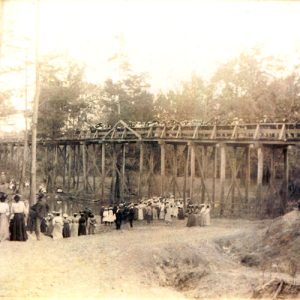 Baptism Service
Baptism Service 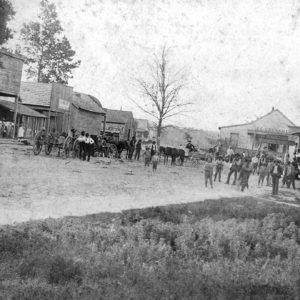 Collins Street Scene
Collins Street Scene  Cut-Off Creek Ravines Natural Area
Cut-Off Creek Ravines Natural Area 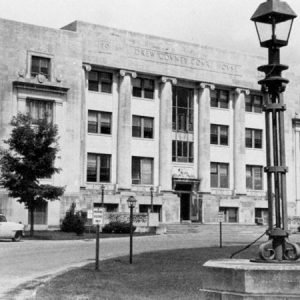 Drew County Courthouse
Drew County Courthouse  Drew County Courthouse
Drew County Courthouse  Drew County Map
Drew County Map  Drew County Museum and Archives
Drew County Museum and Archives  Thomas Drew
Thomas Drew 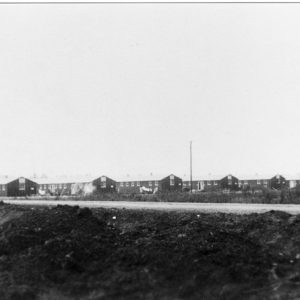 Jerome Relocation Center
Jerome Relocation Center  Lake Monticello
Lake Monticello 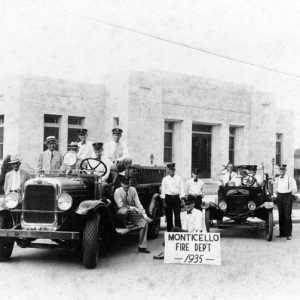 Monticello Fire Department
Monticello Fire Department  Monticello Postcard
Monticello Postcard 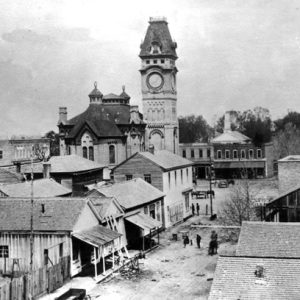 Monticello Street Scene
Monticello Street Scene 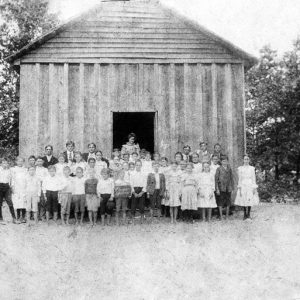 Pleasant Springs School
Pleasant Springs School  Seven Devils Swamp Natural Area
Seven Devils Swamp Natural Area  Warren Prairie Natural Area
Warren Prairie Natural Area 




Comments
No comments on this entry yet.